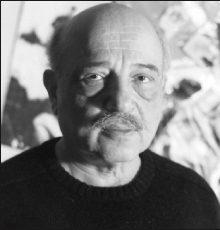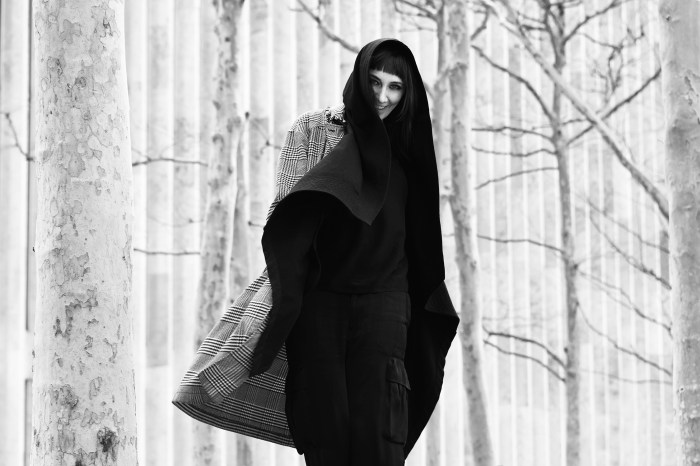By David H. Katz
Lower East Side resident, artist, writer and poet Boris Lurie, a founding member of the NO!art movement, died Jan. 7 in Manhattan of kidney failure brought on by complications of a stroke. He was 83.
Lurie was born in Leningrad in 1924 into an educated and highly cultured Jewish community. In 1925 the family moved to Riga, Latvia. His artistic talent became apparent at an early age. In 1941, after the Nazis invaded the Soviet Union, Lurie, then 17, and his father were taken prisoner. In the next four years they passed through the ghettos and concentration camps of Riga, Salapils, Stutthof and finally Buchenwald-Magdeburg in Germany.
His mother, sister and grandmother were all murdered by the Nazis. These losses, and his own traumatic experiences in the ghettos and camps, profoundly influenced Lurie, informing his later development as an artist. After the war, the social and psychological implications of the Holocaust became primal themes in his painting, sculpture, writing and poetry.
Arriving in New York, Lurie made his way to the Lower East Side and resumed painting in 1946. He began putting his horrific experiences on canvas, despite reluctance among survivors to dwell on, or even publicly mention, their wartime ordeals. In paintings like “Back From Work” (1946) and “Roll Call in Concentration Camp” (1946), Lurie’s stretched, emaciated figures, fluid lines and washed-out tonal palette recall El Greco and Goya. “Entrance” (1946) portrays two wasted sonderkommandos (work unit members) flanking the ramp to the crematorium into which they are forced to shovel the gassed corpses.
Under the influence of de Kooning and, later, Jackson Pollack and other Abstract Expressionists, in the early 1950s Lurie began to explore a number of disparate styles and experimental techniques. His series “Dismembered Women” deals with the loss of the female members of his family; a suite of paintings entitled “Feel Paintings” commenced his long obsession with American symbols of libertine femininity: burlesque dancers, dance hall girls, centerfold models and pinups, an obsession he returned to in the ’70s, when he combined blatantly pornographic images from girlie magazines with typographic elements in a series of powerful poster collages called “Hard Writings.”
In the late ’50s Lurie began to produce ambitious works related in complex ways to his wartime experiences. Along with Sam Goodman and Stanley Fisher, he founded NO!art in 1959, “out of desperation,” he said, both with the state of the art world and the world at large.
While borrowing techniques and motifs from both Abstract Expressionism and, later, Pop Art (which Lurie despised), NO!art was a visceral, contrarian reaction to both of these movements and to their commercial success and widespread acceptance in mainstream culture. The movement’s self-proclaimed aim was to bring the “subjects of real life” back into art. For Lurie and his fellow NO!art malcontents, “real life” encompassed the difficult issues of repression, destruction, depravity, sex, occupation, colonialism, imperialism, racism and sexism.
Perhaps Lurie’s most notorious work was his 1959 “Railroad Collage,” an elaboration of an earlier work, “Flatcar Assemblage by Adolph Hitler” (1945), an appropriation of a horrifying photograph of stacked corpses on a flatcar at Buchenwald. Lurie elaborated the image by superimposing a cutout image from a girlie magazine showing an attractive woman lowering her panties and exposing her ass.
Lurie’s juxtapositions of pornography and Nazism, of pinups and death carts, of vulvas and gas chambers provoked spasms of shock and outrage: It gave voice to the unspeakable affinities between sex and sadism, volition and violation, pleasure and torment, love and death. His approach was considered “over the top” and beyond the bounds of “good taste.” People fled the gallery in a rage and sent letters to editors; there was condemnation, controversy and uproar.
“I would say they were shocked,” Lurie said in an interview in The Villager three years ago. “When you combine extremes like death or injury and all that with sexual aspects, it shocks even today. In other words, if you use pinup girls in order to comment on serious things, it’s confusing because the closed-minded person would react to this semi-pornography in a very hostile way.”
Invariably, this approach put him in opposition to the critics and curators of his day. It was a position he seemed to relish: that of uncompromising iconoclast, nonconformist and scathing social critic.
In the ’60s he continued to explore the long shadow of the Holocaust.
His 1964 “Death Sculpture,” consisting of chicken heads entrapped in a block of synthetic resin, which Lurie said “had something to do with the sudden death of my father,” anticipated Damien Hirst’s modern sculptures of sharks and sheep suspended in formaldehyde. Why chicken heads?
“I wanted to encapsulate death, and that was the only thing that was easily available,” he explained.
Lurie’s brutally honest — some would say cynical, others, self-serving — opinions on the business of art were made clear in 1970 in a statement written for the exhibition “Art and Politics” at Karlsruhe Kunstverein, in Germany, where, in a peculiar and fitting twist of irony, NO!art is celebrated as one of the mid-20th century’s major art movements.
German artist Dietmar Kirves, long an admirer and friend of Lurie, maintains a Web site devoted to the movement’s history, www.no-art.info/, featuring an extensive selection of the work of Lurie and the NO!art artists.
In 1993, Clayton Patterson, the Lower East Side artist, photographer and documentarian, organized the first American show in 29 years of Lurie’s work. Held at the Clayton Gallery and Archives on Essex St., the show rekindled interest in Lurie and the NO!art movement. Through the efforts of Patterson and others, Lurie’s work subsequently appeared in the United States, Latvia and Germany; in 1998 Lurie’s art was exhibited at the opening of the Buchenwald Museum.
In 2004, his inclusion in a group show entitled “The ’80s: 326 Years of Hip,” at the Clayton Gallery & Outlaw Art Museum refocused attention on the raw energy and the uncompromising nature of Lurie’s work.
Lurie never relinquished his anger, a quality in woefully short supply in today’s art world. His aesthetic, he once said, “was to strongly react against anything that’s bugging you.”
Lurie left no immediate survivors. He was buried in Haifa, Israel, in Haifa Cemetery, close to his father.


















